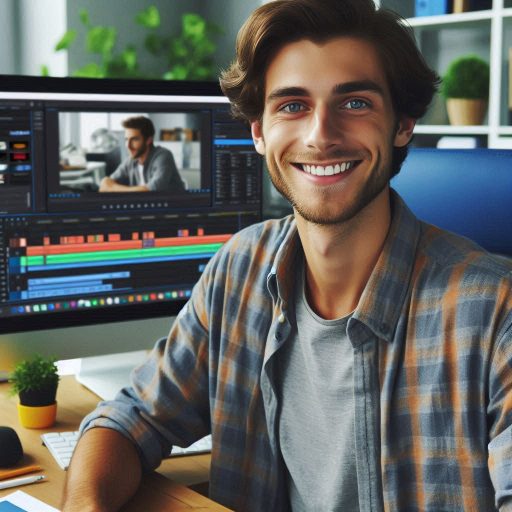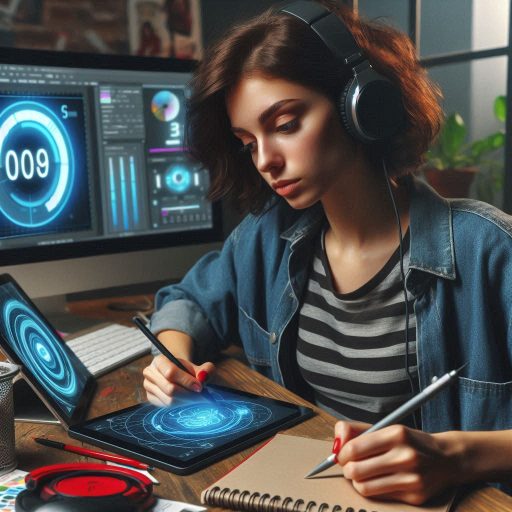Introduction
In this blog post, we will explore Digital Art and Multimedia Design Trends.
Digital art refers to artwork created using digital technology, while multimedia design involves combining different types of media such as text, images, audio, and video.
These fields have experienced significant growth in recent years with the advancement of technology.
- Immersive Experiences: AR and VR technologies are used to create interactive and immersive experiences for users.
- Minimalism and Simplistic Design: Clean and minimalistic designs are becoming popular in digital art and multimedia.
- 3D Design and Animation: The use of 3D design and animation is on the rise, adding depth and realism to digital art and multimedia projects.
- Dynamic Typography: Creative typography designs are being used to make text more visually appealing and engaging.
- Motion Graphics: Motion graphics are being used to add movement and visual interest to digital art and multimedia design.
Artificial Intelligence in Design
Artificial Intelligence (AI) has been making significant waves in the world of digital art and multimedia design.
It is revolutionizing the creative process by providing designers with innovative tools to enhance their work.
How AI is revolutionizing the creative process
- AI brings automation to repetitive tasks, allowing designers to focus on more creative aspects.
- AI tools help generate unique design ideas by analyzing data and patterns.
- AI enables designers to experiment with different styles and techniques effortlessly.
Exploring the use of AI tools
- AI tools like Adobe Sensei and DeepDream help create artistic effects in images.
- RunwayML allows designers to explore new possibilities by integrating machine learning models.
- AutoDraw by Google uses AI to suggest drawings based on rough sketches.
Examples of AI integration in design software
- Adobe Illustrator’s “Neural Filters” use AI to enhance and manipulate images.
- CorelDRAW includes AI-driven features for image tracing and color matching.
- Blender’s AI denoising feature improves rendering and image quality.
Overall, the integration of AI in digital art and multimedia design is pushing the boundaries of creativity and efficiency.
Designers are now able to explore new avenues and experiment with innovative tools that enhance their work in ways never thought possible before.
Read: The Future of Multimedia Art and Design
Augmented Reality (AR) and Virtual Reality (VR) in Art
Augmented Reality (AR) and Virtual Reality (VR) have revolutionized the way digital art and multimedia design are created and experienced.
These technologies have opened up a whole new realm of possibilities for artists to explore and push boundaries in their work.
Impact of AR and VR on Digital Art and Multimedia Design
AR and VR have allowed artists to create interactive and immersive experiences for viewers.
These technologies have blurred the lines between the physical and digital worlds, enabling artists to blend reality with fantasy in their creations.
The use of AR and VR has transformed traditional art forms by adding layers of data, sound, and animation to static images.
Artists can now engage audiences in new ways through dynamic storytelling and interactive elements in their works.
AR and VR have also democratized art by making it more accessible to a wider audience through mobile devices and VR headsets.
How Artists are Using AR and VR to Create Immersive Experiences
Artists are incorporating AR and VR technology to transport viewers to virtual worlds where they can interact with the artwork.
VR allows artists to create 3D environments that viewers can explore from different angles, providing a truly immersive experience.
AR is being used to overlay digital content onto physical spaces, creating interactive installations that respond to viewers’ movements.
Some artists are combining AR and VR with other technologies like motion sensors and haptic feedback devices to enhance the interactive experience.
Artists are also collaborating with software developers and engineers to create custom AR and VR applications tailored to their artistic vision.
Transform Your Career Today
Unlock a personalized career strategy that drives real results. Get tailored advice and a roadmap designed just for you.
Start NowMost Innovative AR and VR Projects in the Field
The Museum of Modern Art (MoMA) in New York City has used AR to bring famous artworks to life through interactive experiences.
Virtual reality artist Laurie Anderson has created immersive VR installations that explore themes of identity and consciousness.
The VOID, a VR theme park, offers visitors the chance to experience fully immersive VR worlds through physical interaction.
Artists like Chris Milk and Marina Abramovic have used AR and VR to push the boundaries of performance art and storytelling.
Google’s Tilt Brush allows artists to create 3D paintings in virtual reality, opening up new possibilities for digital art creation.
In fact, Augmented Reality (AR) and Virtual Reality (VR) have transformed the landscape of digital art and multimedia design, allowing artists to create immersive and interactive experiences that were previously unimaginable.
As these technologies continue to evolve, we can expect to see even more innovative and boundary-pushing projects in the field.
Read: From Concept to Creation: Multimedia Art Workflow
Minimalism and Simplicity in Design
The trend towards minimalistic and simplistic design aesthetics
Minimalism and simplicity have become prevalent trends in digital art and multimedia design.
Artists and designers are embracing clean and streamlined aesthetics to convey their message effectively.
How this trend is being applied in digital art and multimedia design
This trend towards minimalistic design is evident in various aspects of digital art and multimedia design.
From websites to logos, advertisements to mobile apps, minimalism is being applied across the board.
One of the key principles of minimalism is the idea of “less is more.”
By stripping away unnecessary elements and focusing on essential components, designers can create impactful and visually appealing work.
Minimalistic design often features clean lines, ample white space, and a limited color palette.
These elements work together to create a sense of simplicity and sophistication in the artwork.
Many contemporary artists are embracing minimalism in their work, drawing inspiration from the likes of artists such as Ellsworth Kelly, Agnes Martin, and Donald Judd.
These artists are known for their simple yet powerful creations that resonate with viewers.
Examples of artists embracing minimalism
- Ellsworth Kelly: Known for his bold, geometric shapes and vibrant colors, Kelly’s work exemplifies minimalism in its purest form.
- Agnes Martin: Martin’s subtle compositions and use of repetitive lines and grids showcase the beauty of simplicity in art.
- Donald Judd: Judd’s minimalist sculptures, characterized by clean lines and simple forms, reflect his commitment to minimalism.
In short, the trend towards minimalism and simplicity in design is a powerful force in the world of digital art and multimedia design.
By embracing minimalistic aesthetics, artists can create impactful and visually appealing work that resonates with viewers on a deeper level.
Read: Industry Tools Every Multimedia Artist Should Know

3D Printing in Art
3D printing has revolutionized the way artists create physical art pieces by providing them with innovative tools and techniques.
The technology allows artists to bring their imagination to life in ways that were previously impossible.
Benefits of 3D Printing in the Art Industry
- Unlimited Creativity: Artists can design complex and intricate pieces with intricate details that would be challenging to create by hand.
- Time-Saving: 3D printing speeds up the production process, allowing artists to bring their ideas to fruition much faster than traditional methods.
- Cost-Effective: While the initial investment in a 3D printer can be costly, the savings in materials and time make it a financially wise choice in the long run.
- Customization: Artists can customize their creations to suit their specific needs, resulting in unique and personalized art pieces.
Challenges of Working with 3D Printing in the Art Industry
- Technical Knowledge: Artists need to familiarize themselves with 3D modeling software and printing techniques to fully utilize this technology.
- Quality Control: Ensuring the quality and precision of 3D prints can be challenging, as any errors or imperfections can affect the final outcome.
- Material Limitations: The types of materials that can be used in 3D printing are limited, which can restrict the artist’s choice of medium for their art pieces.
- Post-Processing: Finishing and post-processing 3D printed art pieces require additional skills and tools to achieve the desired result.
Impressive 3D Printed Art Pieces
- ‘Bust of Nefertiti‘: A stunning reproduction of the famous Egyptian queen’s bust created using 3D printing technology.
- ‘The Thinker‘: A miniature version of Rodin’s iconic sculpture, showcasing the intricate details that 3D printing can achieve.
- ‘Lace-Like Structures‘: Intricate and delicate art pieces that demonstrate the precision and complexity possible with 3D printing.
- ‘Architectural Models‘: Detailed and accurate models of buildings and structures that highlight the capabilities of 3D printing in architecture and design.
In general, 3D printing has opened up a world of possibilities for artists, allowing them to explore new techniques and push the boundaries of traditional art forms.
While there are challenges to overcome, the benefits far outweigh the difficulties, making 3D printing a valuable tool in the art industry.
Read: How to Network in the Costume Design Industry
Sustainability and Eco-friendly Design
The growing importance of sustainability in digital art and multimedia design
Sustainability is becoming crucial in digital art and multimedia design.
Artists and designers increasingly recognize the need to minimize their environmental impact.
Eco-friendly practices are gaining traction as the art world seeks to address climate change.
How artists are incorporating eco-friendly materials and practices into their work
Designers now incorporate sustainable materials into their projects.
For instance, they use recycled or upcycled materials to create digital art installations.
By repurposing existing resources, artists reduce waste and promote sustainability.
Artists also adopt green technologies in their workflows.
Digital tools and software are evolving to support eco-friendly design practices.
These tools enable artists to create high-quality work while reducing their carbon footprint.
Some of the most innovative sustainable design projects
Some innovative projects highlight the integration of sustainability in design.
One example is the use of solar-powered installations.
These projects harness renewable energy to power digital displays and interactive exhibits.
Another example is the creation of art using biodegradable materials.
Artists are exploring alternatives to traditional, non-renewable resources.
This approach helps reduce environmental impact and supports the circular economy.
Designers are also focusing on virtual exhibitions.
These online platforms reduce the need for physical materials and transportation.
Virtual art spaces are becoming popular, offering an eco-friendly alternative to traditional gallery setups.
Overall, sustainability and eco-friendly design are shaping the future of digital art.
By embracing these practices, artists contribute to environmental conservation while pushing the boundaries of creativity.
The art world is gradually moving towards a greener future, driven by innovation and a commitment to reducing its ecological footprint.
Interactive Design and User Experience
The focus is on creating interactive and engaging experiences for users
Interactive design is a crucial aspect of digital art and multimedia projects.
It involves creating experiences that actively engage users, allowing them to interact with the content in a meaningful and captivating way.
Role of user experience (UX) design in digital art and multimedia projects
User experience (UX) design plays a significant role in ensuring that these interactive experiences are user-friendly and intuitive.
It focuses on understanding the needs and preferences of the target audience to create designs that are both visually appealing and functional.
Examples of projects that prioritize user interaction and engagement
Here are some examples of projects that prioritize user interaction and engagement:
- Virtual Reality (VR) Experiences: VR technology allows users to immerse themselves in a digital environment, providing a truly interactive and immersive experience.
- Augmented Reality (AR) Applications: AR integrates digital elements into the real world, offering users a unique and interactive way to engage with content.
- Interactive Websites: Websites with interactive elements such as animations, scrolling effects, and clickable buttons enhance user engagement and create a dynamic user experience.
- Mobile Apps with Gamification: Gamification incorporates game-like elements into mobile apps, encouraging users to interact with the app in a fun and engaging way.
- Interactive Installations: Physical installations that use digital technology to create interactive experiences, combining art and technology to engage audiences in a unique and immersive way.
By focusing on interactive design and user experience, digital artists and multimedia designers can create compelling and memorable experiences that captivate users and leave a lasting impact.
Explore Further: Interview Tips for Landing a Concept Artist Job
See Related Content: The Future of Set Design: Trends to Watch in 2024
Motion Graphics and Animation Trends
In the fast-paced world of digital art and multimedia design, motion graphics and animation have become essential tools for creating visually captivating content.
Let’s delve into the latest trends in this dynamic field and explore how artists are pushing boundaries with their creative works.
Interactive Motion Graphics
One of the emerging trends in motion graphics is the use of interactive elements.
Artists are incorporating interactive features into their animations, allowing users to engage with the content in a more immersive way.
3D Motion Graphics
With advancements in technology, 3D motion graphics have become increasingly popular.
Artists are leveraging 3D software to create stunning visual effects and realistic animations that bring their designs to life.
Experimental Animation Techniques
Some artists are experimenting with unconventional animation techniques to challenge traditional norms and push the boundaries of creativity.
From glitch art to abstract motion graphics, these innovative approaches are gaining traction in the digital art community.
Cinematic Storytelling
Motion graphics are not just limited to short clips or advertisements.
Artists are now using animation to tell compelling stories with cinematic quality.
By combining stunning visuals with powerful narratives, they are able to captivate audiences and evoke emotions through their work.
Motion Capture Technology
Advancements in motion capture technology have revolutionized the way animations are created.
Artists can now use motion capture data to animate characters in a more realistic and seamless manner, resulting in lifelike movements and expressions.
Incorporating Augmented Reality (AR) and Virtual Reality (VR)
As AR and VR technologies continue to evolve, artists are integrating these immersive technologies into their motion graphics projects.
By blending the digital world with the physical environment, they create interactive and multidimensional experiences for viewers.
Collaborations with Other Artists and Industries
In a collaborative effort to push the boundaries of motion graphics, artists are partnering with professionals from various industries such as music, film, and gaming.
These collaborations result in innovative and groundbreaking projects that showcase the versatility and impact of motion graphics in different contexts.
As we witness the evolution of motion graphics and animation design, it’s evident that artists are constantly innovating and exploring new techniques to create visually striking and engaging content.
By staying up to date with the latest trends and embracing experimentation, artists can continue to shape the future of digital art and multimedia design.
Uncover the Details: How to Curate an Art Exhibit: Step-by-Step Guide
Conclusion
In this blog post, we explored key trends in digital art and multimedia design.
We highlighted the rise of augmented reality (AR) and virtual reality (VR), which are revolutionizing how we experience art.
We also discussed the impact of artificial intelligence (AI) in creating intricate designs and automating processes.
Another significant trend is the use of 3D modeling and animation.
This technology allows artists to create lifelike visuals and interactive experiences.
Additionally, we noted the growing importance of immersive storytelling.
Artists now use various media to engage audiences more deeply and personally.
Keeping up with these trends is crucial in this fast-paced industry.
As technology advances, new tools and techniques continuously emerge.
Staying current ensures that your work remains relevant and innovative.
We encourage you to explore and experiment with these trends in your projects.
Try incorporating AR, VR, or AI to enhance your creative process.
Experiment with 3D elements or immersive storytelling to add depth to your work.
Embracing these trends will help you stay ahead and push the boundaries of digital art and multimedia design.




